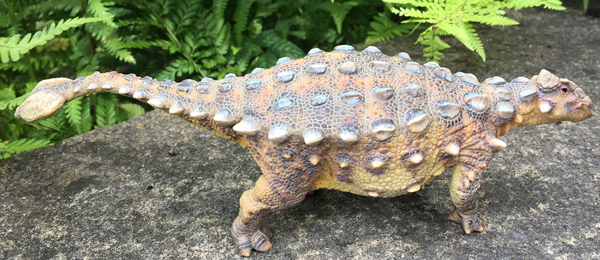Rare Ankylosaur Fossil Turns up in Alberta’s Oil Sands
Oil Worker Digs up Armoured Dinosaur
An oil worker using a mechanical excavator to clear debris in preparation for more crude oil extraction in the vast oil sands field of Alberta (Canada), has unearthed a rare ankylosaur fossil. A surprising find, as the sediments that the fossil was found in were laid down in a marine environment. Occasionally, fossils of ammonites and shellfish are found, but to discover a dinosaur fossil, is extremely unusual.
Ankylosaur Fossil
Scientists have speculated that the carcase of the ankylosaur was probably washed out to sea by a flood event. The heavy armour on the back would have acted as “keel” for the corpse and the body would have floated for some time, buoyed up by gas contained in the stomach and other internal organs. Eventually the body would have ruptured, the gas would have escaped and the remains of this armoured dinosaur would have sunk to the bottom of the sea. Over time, the body would have been covered with sediments and 110 million years later the fossilised ankylosaur was dug up by the surprised oil worker.
The Albertan oil sands, are a huge area of tar and sand which is mined for its crude oil deposits. The sediments were laid down in the Cretaceous and represent a marine environment. Around ten years ago, the fossil of an ichthyosaur (marine reptile), was found in this strata, but to discover a dinosaur in these sediments is most unusual but not completely unknown. For example, in the marine Jurassic strata of Dorset, the fossils of an earlier armoured dinosaur have been discovered- Scelidosaurus.
The Albertan fossil, may represent a new genus of ankylosaur, commenting on the discovery Donald Henderson, the curator at the Royal Tyrrell Museum (Alberta) stated:
“We’ve never found a dinosaur in this location. Because the area was once sea, most finds are invertebrates such as clams and ammonites.”
Researchers have estimated that this dinosaur would have measured in excess of five metres long and would have been at least 2 metres wide.
A Typical Model of an Ankylosaur

“Sede” the Ankylosaurus dinosaur model. Typical ankylosaur model. Picture credit: Everything Dinosaur.
Picture credit: Everything Dinosaur
The ankylosaur model (above) is “Sede” from PNSO. To view the PNSO range: PNSO Age of Dinosaurs Figures.
Photographs show some of the preserved scutes (body armour), the pen provides a scale for the photograph.
Dr Henderson added:
“It is pretty amazing that it survived in such good condition. It is also the earliest partially complete dinosaur that we have from this province [Alberta].”
The fossil is very well preserved and is almost three-dimensional, not having suffered too much compression as the layers of sediments built up on top of the remains.
The ankylosaur was found by a Suncor Energy excavator operator, who ironically had visited the Royal Tyrrell Museum just the week before.
Dr Henderson suggested that the worker had been thinking about dinosaurs and was therefore able to spot the unusual rock that was dug out of the ground:
“Maybe his mind was subconsciously prepared.”
The energy company has suspended excavation work to permit scientists to fully explore the site so that other fossil elements can be safely removed and shipped to the Royal Tyrrell for preparation.

